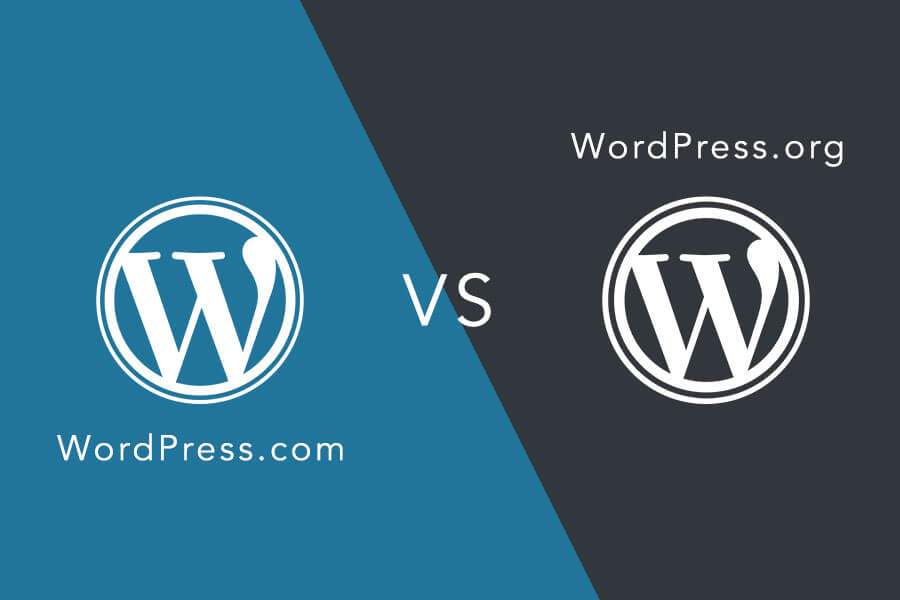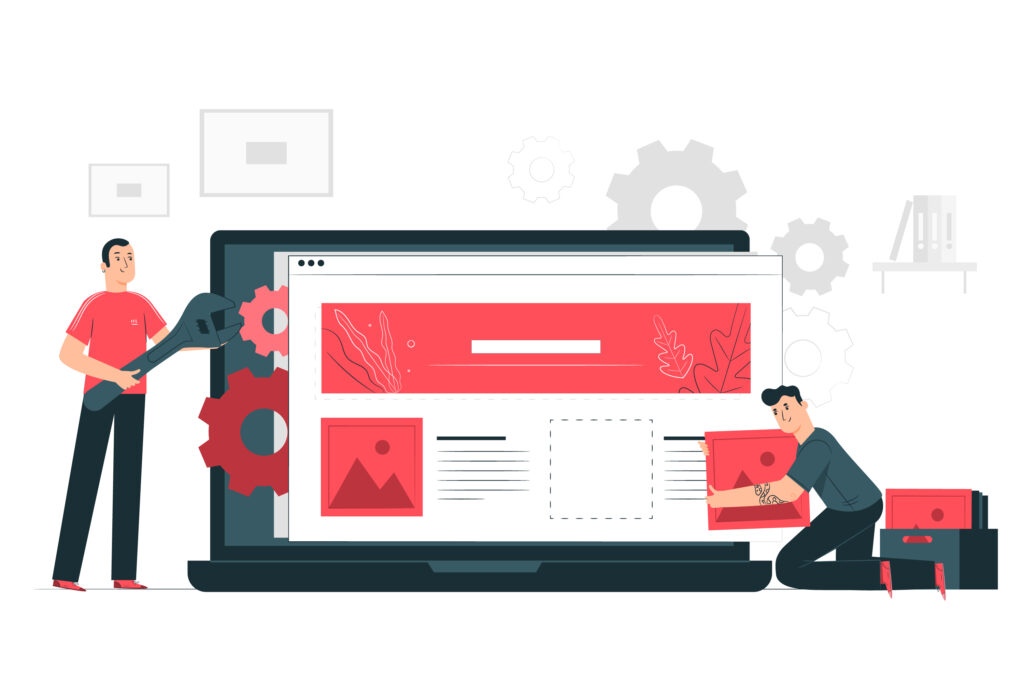People often confuse WordPress.com and WordPress.org. These sites not only share the same name, but the same person, Matt Mullenweg, also founded them. Make no mistake, though; these two websites offer completely different services.
What is the difference between WordPress.com and WordPress.org? WordPress.com is a website where you can only create a blog with certain limitations, while WordPress.org is an open-source Content Management System that allows you to create and host any website.
The main differences between the two websites include:
| Characteristic | WordPress.com | WordPress.org |
| Purpose | To create a limited website, usually a blog. | To design a website with endless possibilities. |
| Cost | Offers a free service and paid plans that range from $4 to $45. | Completely free to use, but you must pay for a hosting site and your domain. |
| Initial Setup | A three-step process followed by a click and drag customization. | An in-depth process that involves creating every aspect of the website. |
| Customization | All customization is limited. | Customization is limitless. |
| Maintenance | WordPress provides all maintenance. | No maintenance is provided. You have to provide your own. |
| Ownership | You do not own your website, no matter your plan. | You own your entire website. |
| Storage | Depending on your plan, you can have anywhere from 3GB to 200GB of storage. | Your hosting service determines the amount of storage you have. |
| Monetization | Free and Personal plans typically do not make money. Limited monetization is available on other plans. | You have complete control over the monetization of your website. |
Each of the services comes with advantages and disadvantages. Depending on what you are looking to do, one service might suit your needs better. Either way, it is better to understand what each website does and make an informed choice. Read on to find out the differences between WordPress.com and WordPress.org and which one is right for you.
The Differences Between WordPress.com and WordPress.org
Believe it or not, there are quite a few important differences between the two websites apart from their top-level domain name (the .org vs. the .com). These differences can be significant when deciding which one of these services you want to use.
The main difference between the websites is their purpose.
- com allows you to create a blog hosted by WordPress; however, you are limited in the things that you can do with your blog.
- org allows you to create an entire website from scratch and customize it exactly how you want it. WordPress does not host for this website, so you will have to find another hosting company.
Many other details differ between the sites. Some of them include:
- Cost
- Initial Setup
- Customization
- Maintenance
- Ownership
- Storage
- Monetization
Before choosing to work with WordPress.com or WordPress.org, you should be aware of what each site offers so that you can make an educated decision.
Cost of WordPress.com
WordPress.com offers both free and paid services. However, if you choose the free version, you will be extremely limited in what you can do with your blog. Furthermore, all free WordPress.com websites have URLs that end with a dot wordpress.com extension.
Choosing the free WordPress.com service results in the following limitations:
- You cannot grow with your blog.
- You cannot customize your blog.
- You do not have much storage.
- You cannot have your domain name.
If you want more freedom with your website, you can purchase a package. There are four package options offered: Personal, Premium, Business, and eCommerce. The plans range from $4/month to $45/month. You can choose the package that fits your needs.
Here are some of the things to consider when choosing your plan. I picked a few from WordPress.com. You can click the link to get the full list of features.
| Features | Free | Personal
$4 |
Premium
$8 |
Business
$25 |
eCommerce
$45 |
| Free Domain for One Year | – | ü | ü | ü | ü |
| Email & Live Chat Support | – | ü | ü | ü | ü |
| Storage Space | 3 GB | 6 GB | 13 GB | 200 GB | 200 GB |
| Dozens of Free Themes | ü | ü | ü | ü | ü |
| Unlimited Premium Themes | – | – | ü | ü | ü |
| Remove WordPress.com Ads | – | ü | ü | ü | ü |
| Advanced Social Media | – | – | ü | ü | ü |
| Google Analytics Integration | – | – | ü | ü | ü |
| SEO Tools | – | – | – | ü | ü |
| Install Plugins | – | – | – | ü | ü |
| Upload Themes | – | – | – | ü | ü |
| Remove WordPress.com Branding | – | – | – | ü | ü |
Cost of WordPress.org
WordPress.org is completely free software. However, you will need to get a hosting service if you want your website to be live on the internet. Hosting sites do require payment.
Some popular hosting sites include:
- Bluehost
- HostGator
- Hostinger
- Go Daddy
- GreenGeeks
The hosting site that you choose is entirely up to you. Since most hosting sites support WordPress, you don’t have to worry about incompatibility.
In addition to the hosting cost, you will have to pay for your domain name, which is approximately $15 per year. When you first purchase your hosting service, most companies will give you your domain name for free for up to one year, after which you will have to pay for it yourself.
Other costs that are associated with your WordPress.org website are optional. You can purchase add-ons, themes, plug-ins, and more to customize your website. Additionally, you can hire a web designer to build your site for you if you’d like.
Controlling the costs of your site is very easy because you choose your hosting and annual domain costs, and you can design your site yourself and limit additional downloads.
Initial Setup of WordPress.com
The steps for creating a website on WordPress.com are incredibly easy.
- Create an account on WordPress.com.
- Choose your plan.
- Create your website.
It’s that simple. Three steps will set up your website. After you’ve created the website, everything is done with a click of a button. You can change the appearance and content of your site according to preset options or other options you have downloaded. However, if you choose the business or eCommerce plans, some additional steps must be followed.
WordPress.com’s goal is to make your website creation experience as smooth as possible. For someone new to website creation or not very tech-savvy, this is a great starting point. Once you’re well-versed in the art of designing and running websites, you can switch your website over to the more customizable WordPress.org.
Initial Setup of WordPress.org
Designing your website with WordPress.org is not as hard as you might think. According to the article “How to Get Started with WordPress: 2019 Guide” by Tom Ewer, there are six main steps for creating a website with WordPress.org, and they are:
- Choose your hosting site. There are both free and paid hosting sites that you can choose from, but the paid hosting sites will offer better services and more features.
- Decide on a domain name. You want to choose a domain name that will interest people enough to want to visit your site while also reflecting your site’s purpose.
- Begin customizing your site. With WordPress.org, you have three options available for your website design: free themes, premium (paid) themes, and a theme customizer.
- Choose plug-ins for more features. Depending on the purpose of your site, you may decide to use plug-ins to help make it more successful. For example, the Yoast SEO plug-in helps to increase your online visibility.
- Create your main pages. Some examples of key pages that many websites feature are Home, Blog, About, Contact, Portfolio, and Store. Your main pages will depend on your website’s purpose.
- Import and export content. There are tools within the website that will help you import and export content easily. These tools help you get your site up and running more quickly. Content brings visitors!
These steps are straightforward, but if you run into any issues, there are many tutorials on the internet that take you step-by-step through the setup process. While WordPress.org entails a lengthier setup process, many people consider the extra work worth it because of the customization the site provides.
Customization of WordPress.com
Unless you have a business or eCommerce plan with WordPress.com, you are unable to customize your website as freely as you would like.
- Domain Name: Unless you have a paid version, WordPress.com will not allow you to have your domain name. A free domain will always have the dot wordpress.com extension. For example, your free website name would read (choose your name).wordpress.com.
- Themes: For the free version, there are a few select themes that are available to you. If you have a personal or premium version, then you have a larger selection of themes to choose from, but they are still limited. The business and eCommerce plans are the only plans that have an unlimited number of themes. Regardless of your plan, you cannot download any themes from outside of the WordPress.com platform.
- Plugins: The various plans offer different numbers of plugins for download. One limitation is that you will not be able to download any third-party plugins to your website.
Customization of WordPress.org
Since WordPress.org is open-source software, you can practically do whatever you want with it. It also gives you the freedom to play around with it for free or pay for the different options.
- Domain Name: When it comes to naming your website, you are free to choose whatever you want without having to worry about an added extension at the end. Most hosting companies provide you a free domain name as a complimentary service for up to a year, after which you will have to pay about $15 per year to keep the name.
- Themes: You will have an unlimited number of themes to choose from. This includes themes that are free, paid, and third-party. Additionally, if you know how to, you can create your themes and upload them for your website. The choice is yours.
- Plugins: You have the freedom to choose any kinds of plugins you wish for your website. Plugins help your website perform at its best and make things easy for you because you don’t have to code everything. There are plug-ins for language conversion, collecting different types of payment, and analyzing your website.
Maintenance of WordPress.com
One of the many advantages of WordPress.com is that they provide all the maintenance for you. They regularly release updates for any security issues on their site and provide technical support if you need it. So, if you have any website related questions, you can always reach out to them, and they will help you. However, if you have a free account, they only provide minimal support.
- Backups: According to WordPress.com, they handle all of their back-ups. “If your blog is hosted here at WordPress.com, we handle all necessary backups. If a very large meteor were to hit all the WordPress.com servers and destroy them beyond repair, all of your data would still be safe, and we could have your blog online within three days (after the meteor situation died down, of course).”
- Updates: The site provides regular updates for all the themes, plugins, and security measures that they offer.
- Security: WordPress.com has plenty of security measures in place to ensure your data and your site visitors’ data is secure.
Some of the things they have in place to protect your site and information are:
- Strong firewalls
- Encryption
- Monitoring for suspicious activity
- Regular security tests
- Provide data backup and recovery measures
- Have a security team in place to monitor everything
- Provide effective guidelines that users can follow to help keep their data safe
When it comes to maintenance, WordPress.com is the much easier choice since it is all taken care of for you.
Maintenance of WordPress.org
WordPress.org does not offer any built-in maintenance. However, depending on the hosting company you use, they might be able to help you. This possibility is why you must always check to see what kind of services a hosting company provides before choosing it.
-
-
-
- Backup: There are plenty of free and paid plugins that can help you back up your website. Some of the most popular ones are UpdraftPlus, Vaultpress/Jetpack, and Backup Buddy. These plugins provide automated real-time back up to a cloud or your computer. You also have the option to schedule a backup at a certain time or back up your content whenever you feel like it.
- Update: It is important to make sure that you are keeping all the parts of your website updated. Sometimes updating these is as easy as a click of a button, and other times you might have to download extensions to make sure that everything still works. In any case, it is all really simple. The hardest part is remembering to check for updates regularly.
- Security: Once again, you are responsible for making sure your site is secure and all the information is protected. Some of the security measures come from your hosting company, and some plugins offer extra security measures. So, you can rest assured that you will be able to protect your website. You’ll just have to put in a bit more work.
-
-
Ownership of WordPress.com
If you have a website with WordPress.com, then your website is owned by WordPress.com. Even if you have the most expensive paid plan, WordPress.com still owns your website.
When you sign their agreement, you give them the rights to your site and content. This means you are not the owner of your site. So, if WordPress decides that you have not abided by their rules and regulations, then they can take down your website, no questions asked. They do not do this often, but they have the power to do it if they want.
You still are the owner of your content, but they have the right to use it if they want for marketing purposes.
Finally, your website will have WordPress.com branding. You can do away with their branding if you purchase the business or eCommerce plans; otherwise, visitors of your website will be able to see the WordPress brand at the bottom of your webpage.
Ownership of WordPress.org
With WordPress.org, you own both your content and your website. Most importantly, there is no WordPress branding.
Storage of WordPress.com
Depending on the kind of plan you have, you can have as little as 3 GB of data storage for your website or as much as 200 GB. The cheaper the plan, the less storage you have.
Storage of WordPress.org
With WordPress.org, your storage comes from the hosting site that you choose. For example, the cheapest plan with Bluehost gives you 50 GB of data storage, and the standard plan with HostGator will give you 150GB of data storage.
Monetization of WordPress.com
When it comes to monetizing your website or blog in WordPress.com, it isn’t as simple as it should be. Certain restrictions are in place that you must abide by if you want to monetize your website.
Some of these restrictions are:
-
-
- You can only use Google AdSense on Business plans.
- You can only use BuySellAds on Business plans.
- You can only have affiliate links if your site is not set up to drive traffic to said affiliate links.
- Sponsored posts are allowed but limited. You cannot have a site where the majority of your posts are sponsored.
- No selling of any kind is allowed unless you have an eCommerce plan.
-
In general, no matter the plan, you are still restricted in how you can make your money. If you have the free or personal plans, then you probably won’t make any money.
Monetization of WordPress.org
With this platform, you have complete authority to do whatever you want. So, you can monetize whenever you are ready. There are plenty of monetization options available to you – from adding different plugins to adding affiliate links to advertising. You even have the option to make a blog that is just for sponsored posts if you feel like it!
How to Choose the Right WordPress Website for You
To determine which WordPress site is right for you, you need to think about what it is that you want to do with your website.
-
-
- Do you want to make money from it?
-
If your main goal is to make an eCommerce website, you can use either of the WordPress sites. However, with WordPress.com, you will have to pay more to get the eCommerce plan to add customizations and plugins to your website. With WordPress.org, you aren’t paying anything extra.
-
-
- Are you looking to grow your blog?
-
There are times when WordPress.com cannot handle the extra traffic or will ask you to upgrade to a higher plan to accommodate your request. In that case, it is better just to change your platform and go for a self-hosting site that is better able to accommodate your growing blog, business, or eCommerce site.
-
-
- Are you planning on branding yourself?
-
If your plans are long-term, then you might as well invest in WordPress.org from the get-go instead of having to move sites in the future. Also, the self-hosting option will give you better options to customize your site to go along with your brand.
-
-
- Do you just want to write a blog as a hobby?
-
If blog writing is a hobby that you don’t dedicate much time to and you don’t care about traffic or growth, then WordPress.com is the best option for you. After all, if you happen to change your mind in the future, you can always switch your site over to WordPress.org.
-
-
- Are you just practicing with a website?
-
WordPress.com is the best way to practice using the WordPress software and familiarize yourself with it. You can do it for free, and you don’t need prior experience to play around with it.
-
-
- Is it for a school project?
-
If you have a school project that requires a website, then you should use the free WordPress.com option to impress your teachers and your classmates.
These are just a few questions that may lead you to decide whether you want to start a website that is temporary or ongoing. Depending on your answers, you can then decide if you want to use WordPress.com or WordPress.org.
You might also want to think about how skilled you are at website building because you will have to do quite a bit of technical work when setting up with WordPress.org. If your tech skills are lacking, you may want to start with WordPress.com, learn how things work, gain some experience, then switch over to WordPress.org.
Essential Plugins for WordPress.com
Plugins come built-in with WordPress.com’s free, personal, and premium plans. You can only choose plugins if you have the business or eCommerce plans.
The built-in plugins include:
- com Stats (our version of Google Analytics)
- Essential SEO (Search Engine Optimization)
- Security Scanning
- Advanced Galleries (tiled, mosaic, slideshows, and more)
- Social Media (add social media buttons to your posts and pages)
- Form Builder (contact forms)
- Extended Customizer
- Extended Widgets (Flickr, Eventbrite, Google Calendar, Twitter, and more)
- Akismet (advanced anti-spam security)
- Backup & Export (24/7 backup of your entire site)
- Importer
- Extended Shortcodes (video, audio, and more)
- Infinite Scroll
- Related Posts
- Email Subscriptions (follow button)
- Advanced Commenting (comment likes, user mentions, notifications, and more)
- Markdown
- Likes (for Posts)
- Embeds (Facebook, Twitter, Instagram, and more)
Included with Premium Plan:
- Custom Design (custom fonts, CSS editor, and more)
- Video Uploading
Included with Business Plan:
- Advanced SEO
- Google Analytics
As mentioned before, WordPress.com highly suggests not using third-party plugins. They have even compiled a list of all plugins that are not compatible with WordPress.com. You can view the comprehensive list on the WordPress.com Incompatible Plugins Support page.
Essential Plugins for WordPress.org
Since you have free reign to download whichever plugins you want for your website on WordPress.org, here are five essentials that you can start with:
- WPForms: This is great for a beginner as well as a professional. You can create forms with the click of a button. It’s great for creating simple contact forms or more elaborate payment forms.
- MonsterInsights: This plugin allows you to have all your Google Analytics information right at your fingertips.
- Yoast SEO: This is one of the most popular plugins. “It helps you add meta tags, generate sitemaps, connect your site to Google Search Console, optimize it for social media, and more.”
- Constant Contact: This plugin allows you to build your email list and enables you to send newsletters to your subscribers without any hassle.
- Sucuri: This plugin provides your website with firewall security, which helps your website stay protected from threats such as malware, DDoS, XSS, etc.
Most Popular WordPress.com Websites
According to WordPress.com, these are some of their most popular users. These companies have their blogs set up using the WordPress.com website.
TED, NBCSports, Gigaom, , TechCrunch, CNN, CBSRadio, Spotify
Most Popular WordPress.org Websites
Many popular websites across the web use the WordPress software. According to WordPress.com,
“It is also the platform of choice for over 35% of all sites across the web.”
Some of their more famous customers include (and these are just a handful, there are plenty more):
RollingStone, Vogue, The Walt Disney Company, Clorox, Harvard Gazette, The Pioneer Woman, Snoop Dogg, and Usain Bolt
In Conclusion
Both WordPress.com and WordPress.org have their advantages and disadvantages. For you to make your decision, you must consider the big picture. What is your goal with your website? This answer will guide to toward the first steps of your making your choice.








